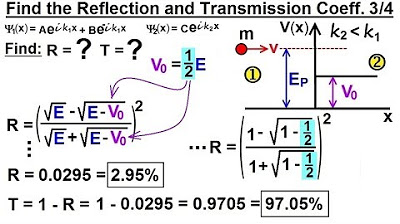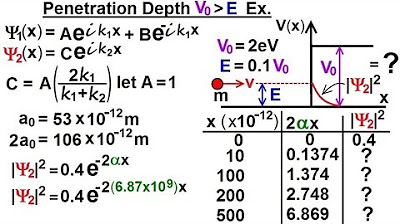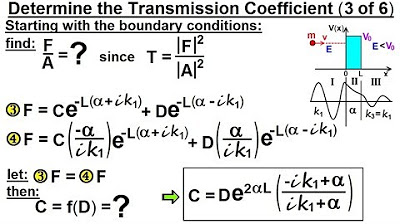Physics - Ch 66 Ch 4 Quantum Mechanics: Schrodinger Eqn (72 of 92) R=? T=? V0=(1/4)E (Ex. 2 of 4)
TLDRIn this lecture, the focus is on calculating the transmission coefficient, which is found to be approximately 99.5%. Using the potential step value of 1/4 the energy of the particle, the equation is solved step by step, leading to a simplified expression. The calculation involves square roots of energy (E) and potential (V), and ultimately confirms the previous result of 99.48% particle transmission when the potential step is a quarter of the particle's energy.
Takeaways
- 📈 The lecture focuses on calculating the transmission coefficient directly.
- 🔄 The previous video established the transmission coefficient to be approximately 99.5%.
- 🌟 The potential step's value is considered to be 1/4 of the particle's energy.
- 🧮 The equation involves the square root of E (energy) and V (potential step).
- 📌 The calculation simplifies to 4 times the square root of V times the square root of 3/4 E.
- 🔢 The denominator is the square root of E plus the square root of e minus V.
- 👓 Further simplification leads to the square root of e times the square root of E.
- 🎯 The final calculation involves the square root of 3/4 and the square root of e.
- 🧠 The square root of e squared cancels out, leaving 4 times the square root of 3/4 divided by 1 plus the square root of 3/4 squared.
- 📊 The numerical value of the square root of 3/4 is approximately 0.866.
- 🎉 The calculated transmission coefficient confirms the previous result of 99.48%, validating the calculation method.
Q & A
What is the topic of the lecture?
-The topic of the lecture is the calculation of the transmission coefficient.
What is the approximate transmission coefficient mentioned at the beginning of the lecture?
-The approximate transmission coefficient mentioned is 99.5 percent.
What value is used for the potential step in the calculation?
-The potential step used in the calculation is 1/4 the energy of the particle.
What equation is used to calculate the transmission coefficient?
-The equation used is T = (4 * sqrt(e) * sqrt(3/4e - V_sub_nought)) / (sqrt(e) + sqrt(e) - V_sub_nought)^2.
What does V_sub_nought represent in the equation?
-V_sub_nought represents the potential of the potential step in the calculation.
How is the equation simplified in the lecture?
-The equation is simplified by canceling out the sqrt(e) terms and factoring out the sqrt(e) in the numerator and denominator.
What is the value of the square root of 3/4?
-The value of the square root of 3/4 is approximately 0.866.
What is the final calculated transmission coefficient?
-The final calculated transmission coefficient is 0.9948 or 99.48%.
What does the transmission coefficient represent in this context?
-The transmission coefficient represents the probability that a particle will be transmitted through a potential step.
How does the potential step affect the transmission of particles?
-The potential step affects the transmission by acting as a barrier; the higher the potential step relative to the particle's energy, the lower the transmission coefficient.
What was the method used to confirm the result of the transmission coefficient?
-The method used was mathematical simplification and calculation using the provided equation and values.
Outlines
📚 Calculating the Transmission Coefficient
This paragraph introduces the calculation of the transmission coefficient, referencing a previous video. It explains the process of using the potential step value of 1/4 the energy of the particle to compute the transmission coefficient. The calculation involves plugging the values into an equation and simplifying it step by step. The result obtained is 99.48%, which matches the expected result from the previous video, confirming the correctness of the calculation.
Mindmap
Keywords
💡Transmission Coefficient
💡Potential Step
💡Quantum Mechanics
💡Particle
💡Energy
💡Square Root
💡Potential Energy
💡E
💡Calculation
💡Probability
💡Simplification
Highlights
The lecture focuses on calculating the transmission coefficient directly.
The transmission coefficient is approximately 99.5 percent, consistent with previous findings.
The potential step's value is set at 1/4 of the particle's energy.
The equation used for calculation involves the square root of e and the energy of the particle.
The transmission coefficient calculation simplifies to 4 times the square root of V times the square root of 3/4 e.
The denominator in the calculation is the square root of V plus the square root of e minus V naught.
Further simplification leads to the square root of e times the square root of E in the numerator.
The denominator simplification involves factoring out the square root of V.
The final calculation shows the square root of 3/4, which is 0.866.
The transmission coefficient is calculated to be 0.9948 or 99.48%.
The result confirms that 99.48% of particles will be transmitted when the potential step is one-quarter the energy of the particle.
The method demonstrates a practical application of quantum mechanics principles.
The calculation process is transparent and methodical, providing a clear guide for similar calculations.
The use of a calculator for the final step emphasizes the importance of precision in scientific calculations.
The lecture provides a detailed walkthrough of the mathematical process, enhancing understanding.
The content is relevant for those studying quantum mechanics and the behavior of particles.
The lecture's approach to explaining the transmission coefficient calculation is both educational and informative.
The lecture's focus on a specific case (1/4 energy potential step) makes the content highly applicable.
The step-by-step breakdown of the calculation helps demystify complex quantum mechanics concepts.
The lecture's emphasis on the transmission coefficient's significance in particle physics is noteworthy.
The use of mathematical notation in the explanation aids in the comprehension of the concepts.
Transcripts
Browse More Related Video

Physics - Ch 66 Ch 4 Quantum Mechanics: Schrodinger Eqn (71 of 92) R=? T=? V0=(1/4)E (Ex. 1 of 4)

Physics - Ch 66 Ch 4 Quantum Mechanics: Schrodinger Eqn (73 of 92) R=? T=? V0=(1/2)E (Ex. 3 of 4)

Physics - Ch 66 Ch 4 Quantum Mechanics: Schrodinger Eqn (67 of 92) Finding R=? T=? Coefficients

Physics - Ch 66 Ch 4 Quantum Mechanics: Schrodinger Eqn (70 of 92) R=? T=? in terms of E & Vo

Physics - Ch 66 Ch 4 Quantum Mechanics: Schrodinger Eqn (76 of 92) Penetration Depth V0, E: Ex.

Physics - Ch 66 Ch 4 Quantum Mechanics: Schrodinger Eqn (85 of 92) Transmission Coeff=? (3 of 6)
5.0 / 5 (0 votes)
Thanks for rating: